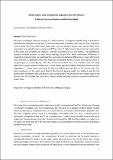Should historic sites protection be targeted at the most famous? Evidence from a contingent valuation in Scotland
Abstract
We used a contingent valuation survey of a random sample of the general public living in Scotland to estimate how willingness to pay (WTP) for the conservation of historic sites (such as castles and stone circles) varies with how well-known these sites are and whether people have visited them. Each respondent was asked to state a maximum WTP in terms of higher income taxes for the conservation of two sites, one of which was "famous" and one of which was less well-known. The hypothetical scenario involved payment to avoid future damage to each site. When observable differences in respondent characteristics are controlled for, we found no significant differences in mean WTP across sites. However, a significant effect was found for respondent familiarity with each site (in terms of recognising it on a photograph), with sites which respondents were more familiar with attracting higher WTP values. Distance effects on WTP were mixed: significant effects of distance of the site from respondents' homes were only found for the less well-known sites, but not for famous sites. The main conclusions of the study were that (i) the Scottish general public are willing to pay for the conservation of historic sites and that (ii) such values exist as much for less well-known sites as for famous sites. This implies that public funds should not be allocated solely to conservation of the best-known sites.
Citation
Kuhfuss , L L , Hanley , N D & Whyte , R 2016 , ' Should historic sites protection be targeted at the most famous? Evidence from a contingent valuation in Scotland ' , Journal of Cultural Heritage , vol. 20 , pp. 682-685 . https://doi.org/10.1016/j.culher.2016.01.004
Publication
Journal of Cultural Heritage
Status
Peer reviewed
ISSN
1296-2074Type
Journal article
Description
This research was supported by Historic Environment Scotland.Collections
Items in the St Andrews Research Repository are protected by copyright, with all rights reserved, unless otherwise indicated.

